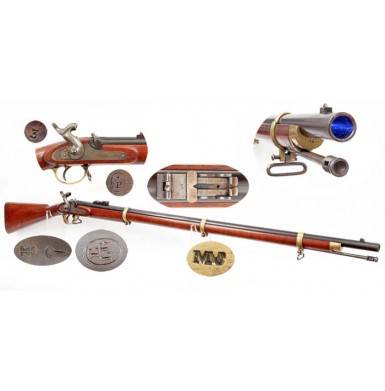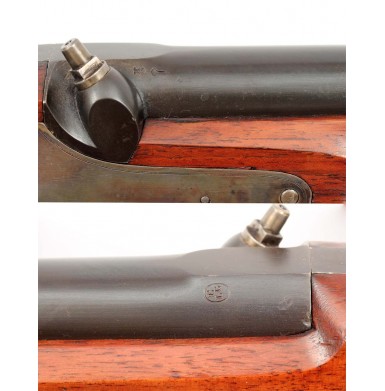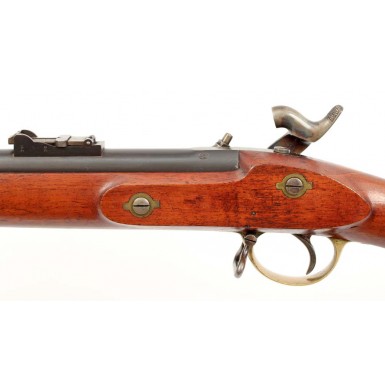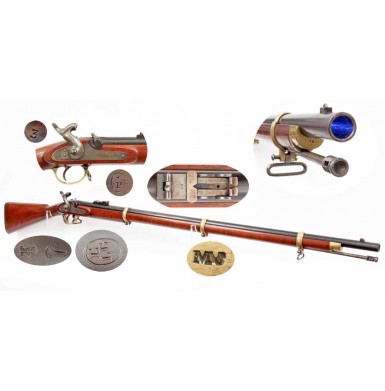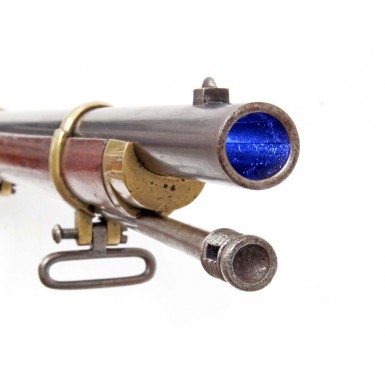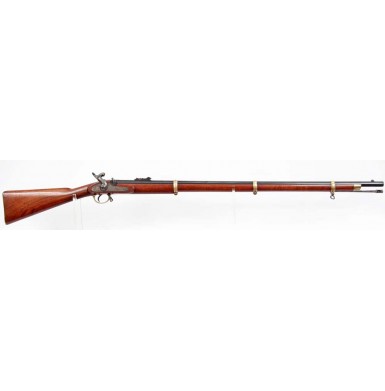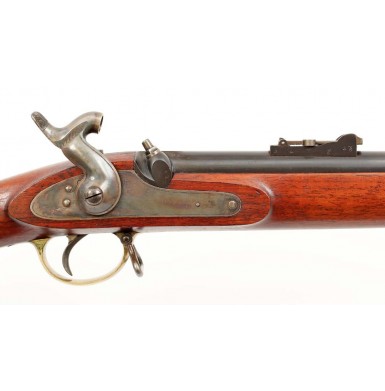Belgian M-1853 Enfield Rifle Musket - About Mint
- Product Code: FLA-2167-SOLD
- Availability: Out Of Stock
-
$1.00
Offered here is a simply outstanding example of the Pattern 1853 Enfield Rifle Musket as produced by the prolific gun trade in Li’ge, Belgium. The Li’ge gun trade had a long history of producing arms of previously established patterns to supplement the arms making capabilities of other nations. By the mid-19th century, the Li’ge arms trade had been producing gun parts to support the Birmingham & London gun trades for well over 100 years. The Belgian makers were also the traditional source for additional British military arms during periods of need greater than could be accommodated by the London and Birmingham makers. With the advent of the Crimean War, the British Government turned to the Li’ge trade to supplement the manufacturing capabilities of their domestic gunmakers. The first Belgian contract for P-1853 Enfield Rifle Muskets was for 20,000 stands of arms. The contract commenced on October 31, 1854 and the arms were to be delivered by May 31 of the following year. With the ending of the war in February of 1856, the critical need for arms was temporarily alleviated, but the British War Department still let an additional contract for 5,000 more P-1853s from Li’ge in June of 1859. By the time the American Civil War erupted in April of 1861, the Belgian trade had several years of experience in the production of the most advanced and widely used muzzle loading military rifle musket in the world, and were tooled up to produce the pattern in quantity. The Li’ge makers found a lucrative market for P-1853s with the American combatants. Many of the brokers who purchased thousands of continental arms for the US government, like Herman Boker & Co and James Hoey purchased Belgian made Enfields, along with arms from Austria, Prussia and France. While it is unclear how many Belgian made P-1853 rifle muskets were purchased by the combatants during the conflict, it is quite clear that many were. It is also quite clear that the British gun trade had long relied upon Belgian makers to supplement their output, and it is quite likely that a large number of the Enfields delivered on British contracts to the North and South included at least some Belgian made arms, and even more arms with Belgian made components. The makers of the Li’ge trade would often produce complete arms that were almost completely unmarked externally, allowing the purchaser to mark them as if they were their own product. This proclivity sometimes makes the recognition of Belgian produced arms somewhat difficult.
This Belgian made P-1853 Enfield Rifle Musket is a perfect example of one of those Li’ge made weapons. The gun is in an absolutely outstanding state of preservation, and is truly in about MINT condition. It is the finest condition Enfield that I have ever had the pleasure to offer for sale. Externally, the gun bears very few marks and tells us very little of its origin, other that it is of Belgian manufacture. The lock shows the typical double boarder line engraving found on most Birmingham and some London contractor produced Enfields, but is unmarked except for a small * / P within in an oval, on the upper edge of the lock, near the hammer. In fact, the mark is placed in such a way that it is only visible when the hammer is cocked. The hammer is engraved with the typical “feathers’ that one expects to find on Birmingham and some London made Enfields as well. The left side of the breech bears the typical Belgian Perron inspection mark, used to proof breeches from 1853 onward. The same area also bears a (CROWN) / X proof or inspection mark that I am not familiar with. The left side of the breech bears a typical 19th century Belgian definitive muzzle loading proof mark, the letters E / LG in a large oval. The inside neck of the hammer is marked with the number 3, and a small, two character marking that my eyes can’t make out is visible on the edge of the cone (nipple) shoulder. All three barrel bands are marked with the letters MC on their lower reverse, near the tension screw. The internal marking provide little information as well. The lock plate is marked with a 3 inside, matching the mark on the hammer neck, and the upper edge has the mating mark: \ / | |. This same mating mark is found under the barrel, with the number “3” between the two sets of slashes, so that it reads \ / 3 | |. This mark obviously mated both in terms of the file slashes and the Arabic number. The same file slash mating marks are present on the necks of the screws of the lock and barrel mounting screws as well. The underside of the barrel is also marked with the letters LWH, the number 18, a script L, the letters LD and an M within a circle. The “L” is a Belgian proof and inspection mark, but the other marks likely refer to the barrel maker and possibly the maker of the gun. The interior of the barrel bands are marked with a G. As noted earlier, the gun is truly in about MINT condition and shows no use, and only the most minor indications of handling and wear. The barrel retains about 98%+ of its original blued finish, with only the most minor loss along high edges and the muzzle crown, and some tiny areas that show very minor fading. The barrel is as close to factory new as you can possibly find on a 19th-century rifle musket. The bore of the musket is in equally EXCELLENT condition, and is bright and shiny with excellent rifling. Interestingly the bore is rifled with four grooves, not the traditional three grooves. The lock and hammer both retain about 95%+ of their original case hardened coloring, with no real loss, but some minor fading to the vivid colors due to age. The lock and hammer show mottled grays, blues and purples, with a tobacco brown undertone. The lock is extremely crisp and is mechanically excellent, functioning perfectly on all positions. The gun is 100% complete, correct and original throughout. It retains its original long-range rear sight, the front site/bayonet lug and both of its sling swivels. The ramrod appears to be the original, period Enfield pattern rod that came with the gun. It is full length and retains excellent threads on the reverse end. The barrel bands are unusual, in that they are made of brass instead of steel, but they make the gun very attractive, as they compliment the brass buttplate and triggerguard. The bands are all matching and all retain their original screw keeper at the end of the tension screw, which prevents the screw from being completely removed from the barrel bands. The bands and the remainder of the brass furniture have a gorgeous golden color, suggesting that they were lightly cleaned years ago and are just starting to mellow slightly. A tinge of green verdigris is present around the edges of the bands where they contact the stock, suggesting the cleaning was a very long time ago. The stock of the gun is in equally wonderful condition as the metal, and the wood to metal fit is outstanding throughout. The stock has never been sanded or cleaned and retains, excellent, like new edges and lines. The stock shows only a very few minor bumps and dings from handling and storage. The most notable being a thumb sized depression on the reverse of the stock, between the middle and upper barrel bands. This is really a minor issue, but is mentioned due to the outstanding condition of the balance of the gun. The stock is complete, solid and free of any breaks, cracks or repairs. The stock has a lovely straight grain and a very nice medium brown tone with strong hints of orange in the coloration.
Overall this is simply a fantastic, nearly mint, as issued condition example of a commercial Belgian manufactured P-1853 Enfield Rifle Musket. It is impossible to know what market this gun was intended for, but it is clear from the non-standard features of brass barrel bands and four-groove rifling that it was never destined for use by the British military. Whether this gun was made to fill a northern or southern Civil War contract is impossible to know. It could have been manufactured for commercial sale anywhere in the world during the mid-19th century. What is clear is that it is absolutely gorgeous and in pristine condition that would be nearly impossible to improve upon. Every collection of P-1853 Enfields needs to have at least one Belgian contract made musket in it (along with the even rarer French, German and American made ones”.). This gun is absolutely stunning, and will be a real centerpiece in an advanced collection of high condition Civil War era long arms.
SOLD
